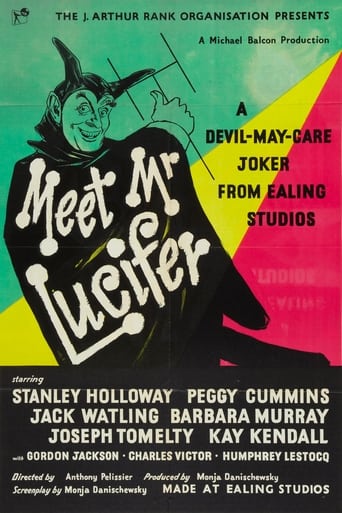cmcastl
Just seen it again after many years, and what now impresses me is a a surprisingly good and sharp script. The script's critique of the negative effects of TV addiction is excellent and prescient for its day, considering how early this film was made into the march of TV (1953) which would eventually supplant film as the medium for our diet of social media.Incidentally, my parents had a set for the 1953 British Coronation, amongst the first in their neighbourhood and thus became that day a focal point for all those who did not yet have a TV.The Miss Lonelyhearts segment would work today in the way it could manipulate all those Mr. Lonelyhearts out there. Kay Kendall was never so alluring.Having said that, TV is today as important to me as it is to anyone else, at least where news and documentaries are concerned. There are, probably, some good effects in the ubiquity of TV, but I personally wonder what the final balance is. It is interesting that the science fiction writer Arthur C. Clarke observed how, along with Marshall Mcluhan, the Canadian media commentator, that TV has created a 'global village' and even the poorest of households will own a TV, even in the worst of slums or favelas, as they are known in South American. Indeed, I suspect that the social glue holding Latin American countries together are its soaps. That may hold good for the West, too. But back to the film; the ensemble acting is excellent, with Stanley Holloway as its focal point, but, goodness me, how gorgeous a young Barbara Murray and Peggy Cummings are, how they brighten the dreariness and blight of a post-war Britain all too slowly recovering from its wounds.
howardmorley
This film resonated with me being born in 1946 whose family first had a Murphy t.v.set in 1954 with its single BBC channel.Previously, my father had to drive us to his sister's house she shared with my paternal grandmother whose family already had bought a TV in 1953 on which we all saw the Queen's coronation that year.In the early part of 1954 we too had a roomful of neighbours & friends who did not possess a t.v. but who wished to view the novelty of watching t.v.London Live t.v. channel in the London area where I live are currently transmitting a collection of Ealing films mainly from the 40s & 50s and although I watch new ones whenever possible, "Meet Mr. Lucifer" had passed me by previously.This film had a galaxy of well known film stars which you can glean from the full cast list on IMDb.com.My favourite was seeing the late Kay Kendall playing "Miss Lonely Hearts Club" although I suspect it was not her voice that was dubbed onto the soundtrack.Very enjoyable I rated it 7/10.
mappman728
One of the Ealing comedies that doesn't get written about very often and not one of the best. However, it does offer an insight into the film industry's fear of television in the early 1950s, with some fairly barbed satire at the expense of the "box in the corner" and its uncritical audience. Th plot seems to be a hybrid of the stage play on which the film was based - television wreaks various degrees of havoc on three households - and a surreal narrative link showing that the Devil (aka Mr Lucifer) is behind television's growth. Apparently he likes to invent something new to make each generation miserable. Television in the 1950s and - if a sequel threatens - mobile phones for the 2000s. Incidental pleasures include an appallingly tatty Christmas pantomime, with desperate performers facing a meagre and hostile audience, and a square dance involving television dancers, friends and neighbours gathered round the television, and a bunch of street urchins and ragamuffins, some of whom look uncannily like Margaret O'Brien in the Halloween sequence of "Meet Me in St Louis". It also convincingly depicts the grime and dilapidation of post-war London, with characters forced to live in cramped basements and seedy bedsits.
JohnHowardReid
This anti-television vehicle commences its tirade most promisingly. The characters are introduced in capital style, while the proposition that TV is an instrument of the devil will fall on many a sympathetic clerical ear. Unfortunately, the producer has obviously blown most of his budget on the earlier scenes, and then spent his reserves on the concluding sequence in which a myriad number of workers in an enormous office are employed sending out lonely heart letters.The rest of the action, alas, wallows in tedious additional dialogue and small-budget clichés which are now and again relieved by the welcome entrance of Stanley Holloway.All the same, the film does present some worthwhile ideas. True, the conclusion seems like an arbitrary appendage to the main plot, but the real problem is that none of the three stories actually do justice to their fascinating characters.All the players are excellent. Stanley Holloway, Joseph Tomelty and Peggy Cummins never deliver less than top-notch performances, but the real surprises are a charismatic Jack Watling and normally dull Gordon Jackson (of all people) doing full justice to a character role.At times, Pelissier's direction seems admirably imaginative, especially in the panto sequences.


